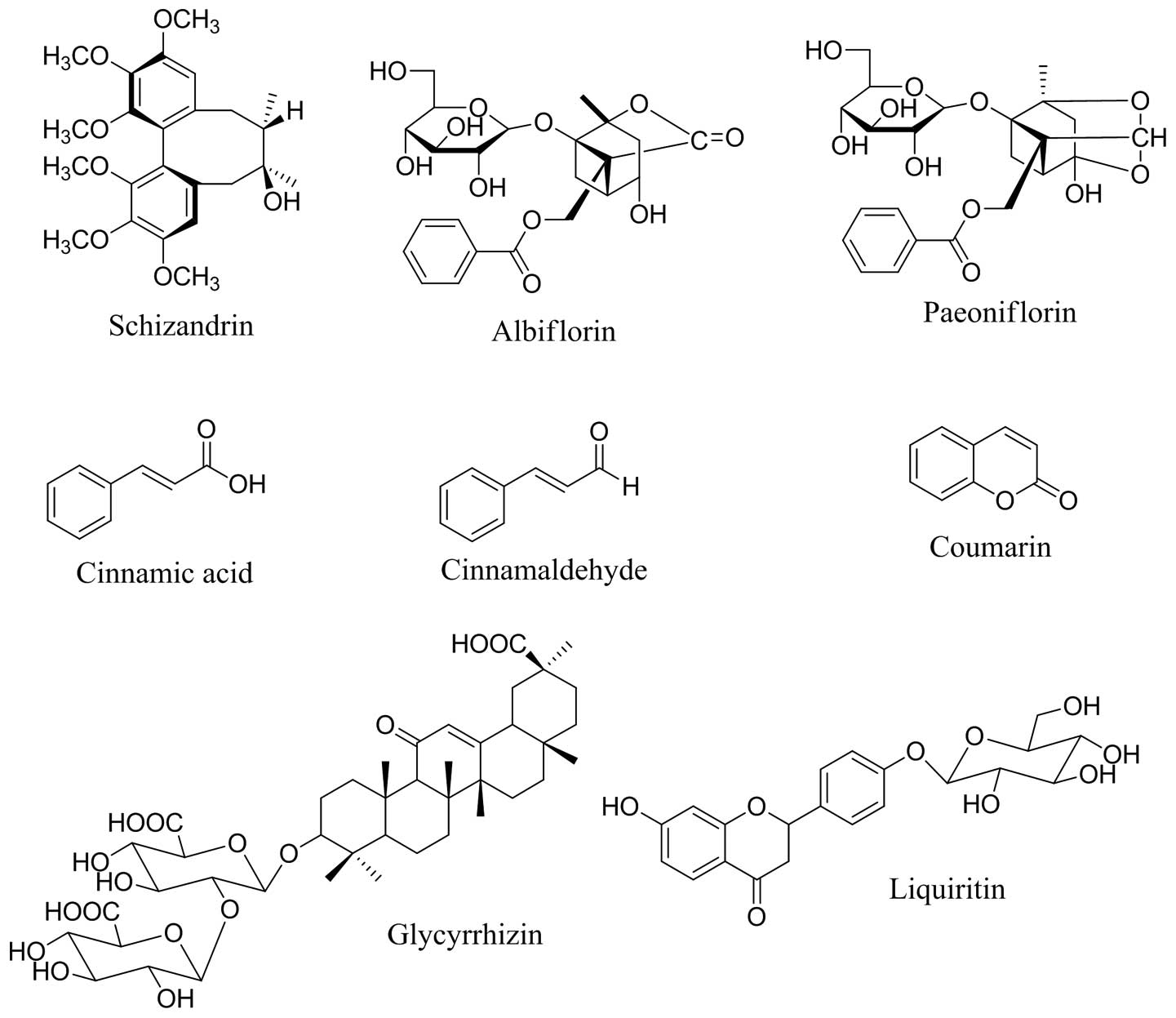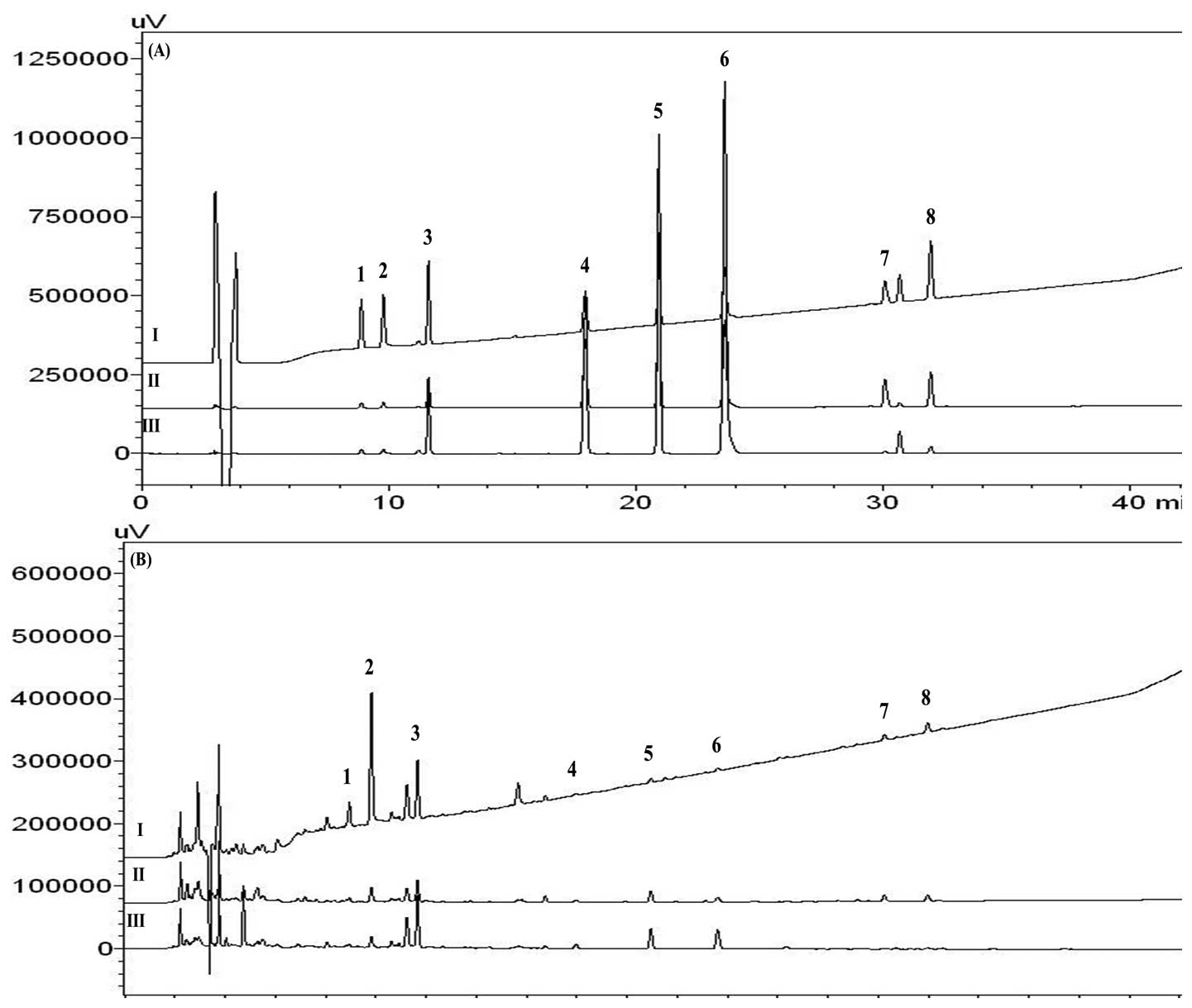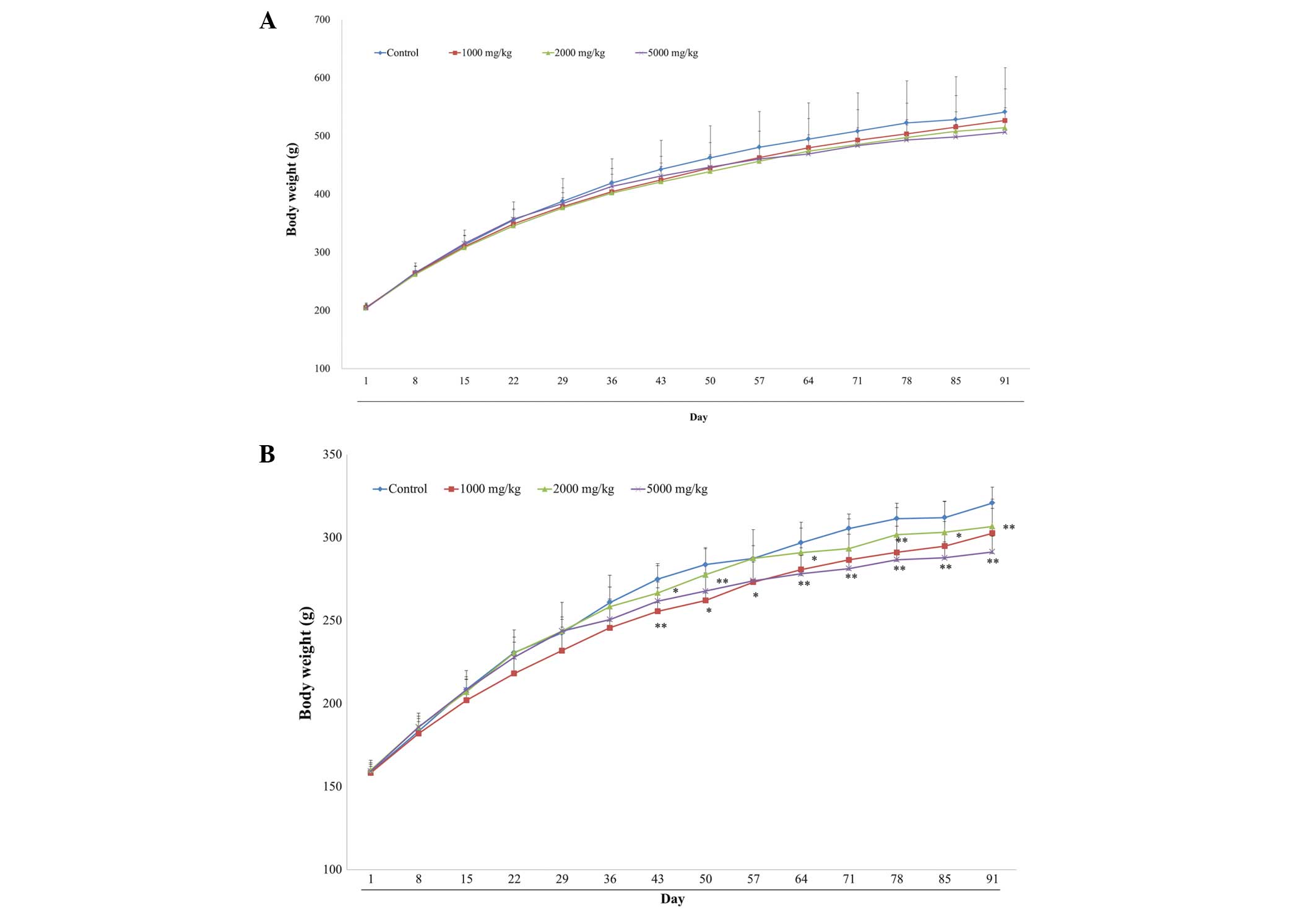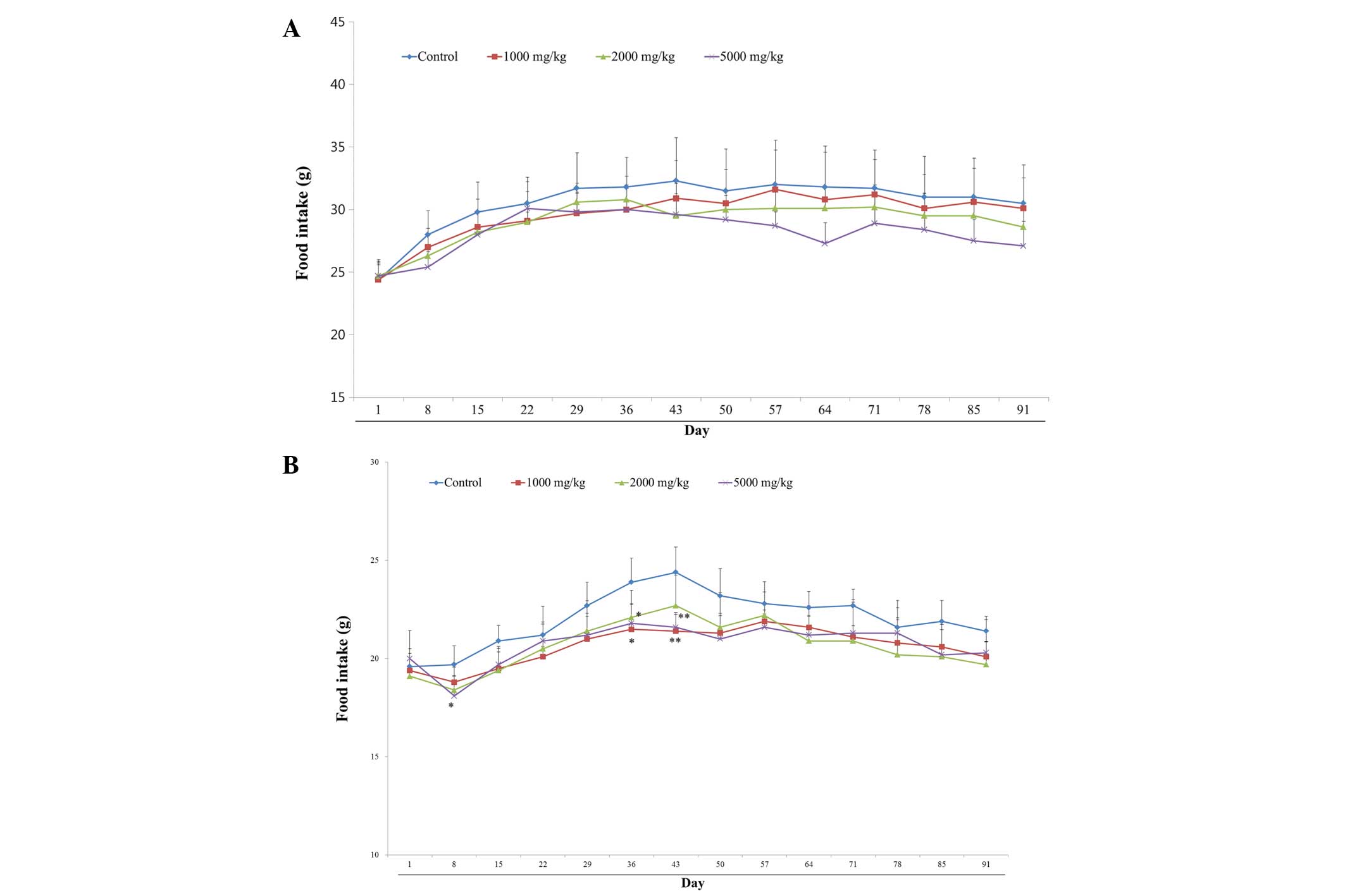Safety assessment of So‑cheong‑ryong‑tang: Subchronic toxicity study in Crl:CD Sprague Dawley rats
- Authors:
- Published online on: April 3, 2014 https://doi.org/10.3892/mmr.2014.2114
- Pages: 2273-2282
Abstract
Introduction
Herbal products are of interest to numerous patients and health care practitioners, as ~70% of the population worldwide rely on herbal medicines for part of their primary health care (1). Concerns have been raised over the lack of scientific evidence regarding the efficacy and safety of herbal products (2,3), although certain products have been verified by Western experimental methods. Traditional herbal medicines are composed of multiple individual herbs. The combination of multiple drugs is considered to maximize the therapeutic efficacy by facilitating synergistic actions between the drugs while preventing potential adverse effects. Therefore, traditional herbal medicine is often considered to be a safe alternative to synthetically manufactured drugs (4). However, previous studies have demonstrated that herbal formulas may have adverse effects (5,6,7).
So-cheong-ryong-tang (Xiaoqinglong-tang in Chinese and Sho-seiru-to in Japanese), is a traditional herbal formula consisting of eight medicinal herbs: Herba Ephedrae, Radix Paeoniae, Tuber Pinelliae, Fructus Schisandrae, Ramulus Cinnamomi, Radix et Rhizoma Asari, Radix et Rhizoma Glycyrrhizae and Rhizome Zingiberis. It is used for the treatment of disorders caused by incomplete treatment of colds, including disturbances in the epigastric region evoked by pathological water retention, dry retching, fever and cough with dyspnea (8).
Thus, as part of the evaluation of the safety of So-cheong-ryong-tang aqueous extract (SCRT), an evaluation of the potential subchronic toxicity of SCRT was conducted using a standard battery of tests recommended by the Korea Food and Drug Administration.
Materials and methods
Reagents and materials
Coumarin and cinnamic acid were purchased from Sigma-Aldrich (St Louis, MO, USA). Albiflorin, paeoniflorin, cinnamaldehyde, glycyrrhizin and schizandrin were obtained from Wako Chemicals (Osaka, Japan). Liquiritin was purchased from NPC BioTechnology Inc. (Daejeon, Korea). The purity of each component was determined to be ≥98% by high-performance liquid chromatography (HPLC) analysis. HPLC-grade reagents methanol, acetonitrile and water were obtained from J.T. Baker Chemicals (Phillipsburg, NJ, USA). Acetic acid was procured from Junsei Chemical Co. (Tokyo, Japan). The materials comprising SCRT were purchased from Kwangmyungdang Medicinal Herbs (Ulsan, Korea). The origin of the sample was confirmed taxonomically by Professor Je-Hyun Lee, Dongguk University (Gyeongju, Republic of Korea). A voucher specimen (2012-KE13-1-KE13-8) was deposited at the Basic Herbal Medicine Research Group, Korea Institute of Oriental Medicine (Daejeon, South Korea).
Preparation of standard solutions and calibration curves
Standard stock solutions of eight compounds, albiflorin, paeoniflorin, liquiritin, coumarin, cinnamic acid, cinnamaldehyde, glycyrrhizin and schizandrin (Fig. 1) were dissolved in methanol at concentrations of 1 mg/ml and stored below 4°C. All calibration curves were obtained by assessment of the peak areas of standard solutions in the following concentration ranges: Albiflorin and liquiritin, 0.78–100.00 μg/ml; paeoniflorin, 1.56–200.00 μg/ml; and coumarin, cinnamic acid, cinnamaldehyde, glycyrrhizin and schizandrin, 0.39–50.00 μg/ml.
Preparation of SCRT and sample solutions
So-cheong-ryong-tang is composed of eight herbs (Table I); 72.0 kg was extracted with distilled water at 100°C for 2 h using a herb extractor (COSMOS-660; Kyungseo Machine Co., Inchon, Korea). The extract mixture (SCRT) was filtered using a standard sieve (no. 270; 53 μm; Chung Gye Sang Gong Sa, Seoul, Korea) and freeze-dried (9.3 kg; PVTFD100R; IlShin BioBase, Dongduchun, Korea). The yield of the extracted solid material was 12.9%. Lyophilized SCRT (200 mg) was dissolved in distilled water (20 ml) and mixed. The solution was filtered through a SmartPor GHP syringe filter (0.2 μm pore size; Woongki Science, Seoul, Korea).
HPLC conditions
Simultaneous analysis using a Shimadzu LC-20A HPLC system (Shimadzu Co., Kyoto, Japan) was performed, consisting of a solvent delivery unit, an online degasser, a column oven, an autosampler and a photodiode array (PDA) detector. The data were processed using the LCsolution software version 1.24 (Shimadzu Co.). The analytical column used for separation was a Gemini C18 (250×4.6 mm; particle size 5 μm; Phenomenex, Torrance, CA, USA) maintained at 40°C. The mobile phases consisted of (A) 1.0% (v/v) aqueous acetic acid and (B) 1.0% (v/v) acetic acid in acetonitrile. The gradient flow was as follows: (A)/(B) = 85/15 (0 min) → (A)/(B) = 35/65 (35 min) → (A)/(B) = 0/100 (45 min; hold for 5 min) → (A)/(B) = 85/15 (55 min; hold for 15 min). The flow rate was 1.0 ml/mm and the injection volume was 10 μl. The PDA detector was monitored at 230, 254 and 250 nm.
Stability
The stabilities of albiflorin, paeoniflorin, liquiritin, coumarin, cinnamic acid, cinnamaldehyde, glycyrrhizin and schizandrin over 7 days were determined using sample solutions assessed at 0, 1, 3, 5 and 7 days.
Animals
Male and female Crl:CD Sprague Dawley (SD) rats (five weeks old) were obtained from a specific pathogen-free facility at Orient Bio Co. (Seoul, Republic of Korea). Animal housing conditions were as described previously (9). This study was performed at the Korea Testing and Research Institute and the study protocol was approved by the Institutional Animal Care and Use Committee according to the Guidelines for Toxicity Tests of Drugs and Related Materials (Document no. 2012-86) as prepared by the Korea Food and Drug Administration (KFDA; 2012). These experiments were performed according to the Organization for Economic Cooperation and Development (OECD) Principles of Good Laboratory Practice (1997).
Dose selection and group assignment
To assess the potential toxicity of repeated exposure of SD rats to SCRT, the dose levels for a 13-week subchronic toxicity study were selected. The dose selection study was performed as previously described with certain modifications (9). In the previous dose selection study that assessed doses of 0, 1,000, 2,000 and 5,000 mg/kg of SCRT in a four-week repeated-dose regime, treatment-associated abnormal clinical signs were observed at the highest dose, 5,000 mg/kg/day. Therefore, for the present 13-week repeated-dose study, doses of 0, 1,000, 2,000 and 5,000 mg/kg/day were selected. Healthy male and female rats were randomly assigned to four experimental groups (SCRT 0, 1,000, 2,000 and 5,000 mg/kg/day groups) and a control group. Each group consisted of 10 rats of each gender. As the oral route is the clinically intended route for the administration of SCRT, oral administration for the present study was selected. Distilled water was administered to the animals in the vehicle control (SCRT 0) group.
Mortality and clinical signs
Mortality and clinical signs were recorded as described previously (9).
Body weight
Body weights were determined as described previously (9).
Food and water consumption
Once before dosing started and approximately once a week thereafter, the quantities of food and water administered and remaining the next day were measured to calculate the difference, which was regarded as the daily consumption.
Ophthalmological examination and urinalysis
An external eye examination and urine assay were performed as described previously (9).
Hematological analysis
Animals fasted overnight prior to necropsy and blood sampling. The blood samples were collected into tubes containing EDTA-2K (Sewoon Medical Co., Seoul, Republic of Korea) and were analyzed to determine red blood cell count (RBC), hemoglobin concentration, hematocrit, mean corpuscular cell volume (MCV), mean corpuscular cell hemoglobin concentration (MCH), platelet levels, numbers of large unstained cells, white blood cell count (WBC) and differential WBC. Hematological parameters were measured using an ADVIA 120 Hematology System (Bayer, Tarrytown, NY, USA), with the exception of prothrombin time (PT) and activated partial thromboplastin time (APTT), which were analyzed using blood samples treated with 3.2% sodium citrate on an ACL 9000 analyzer (Instrumentation Laboratory, Milan, Italy).
Serum biochemistry
Serum biochemical assays were performed as described previously (9). Serum biochemistry parameters examined included the levels of blood urea nitrogen (BUN), alanine aminotransferase (ALT), aspartate aminotransferase (AST), alkaline phosphatase (ALP), creatinine (CREA), glucose (GLU), total cholesterol (TCHO), albumin/globulin ratio (A/G), total protein (TP), albumin (ALB), creatine kinase (CK), triglycerides (TG), total bilirubin (TBIL), phospholipids (PL), γ glutamyl transferase (GGT), calcium (Ca), inorganic phosphorus (IP), chloride (Cl), sodium (Na) and potassium (K).
Organ weights
The absolute weights of the brain, pituitary gland, adrenal gland, liver, spleen, kidneys, heart, thymus, lungs, salivary gland, thyroid glands/parathyroid, testes, epididymides, seminal vesicles, prostate, uterus/cervix and ovaries were measured and the relative organ weight (organ/body weight) was calculated.
Gross findings
At scheduled termination, all surviving animals were anesthetized by isoflurane inhalation, blood samples were obtained and then the rats were sacrificed by exsanguination from the aorta. Complete gross examination of all the animals was performed.
Histopathology
Histopathological examinations were performed as described previously with certain modifications (9). Organs, including kidneys, urinary bladder, liver, heart, spleen, thymus, salivary glands, aorta, pancreas, tongue, skeletal muscle, sciatic nerve, brain, thoracic spinal cord, eyes, optic nerves, lungs, trachea, thyroid, parathyroid, adrenal gland, mandibular lymph node, harderian glands, esophagus, stomach, duodenum, jejunum, ileum, cecum, colon, rectum, mesenteric lymph nodes, skin, mammary glands, sternum/marrow, femur/marrow, testes, epididymides, prostate, seminal vesicles, ovaries, uterus/cervix and vagina of all the groups were stained with hematoxylin and eosin solution following fixation with 10% formalin or Bouin’s solution (only for the testes and epididymides) or Davidson’s solution (only for the eyes and optic nerve), then embedded in paraffin. A full histopathological examination was performed for all tissues from rats from the control and highest dose groups.
Statistical analysis
Statistical analysis was performed as described previously with certain modifications (9) using the PATH/TOX SYSTEM (version 4.2.2; Xybion Medical Systems Corporation, Cedar Knolls, NJ, USA) and SAS version 9.2. P<0.05 was considered to indicate a statistically significant difference.
Results
Stability
The stability of the eight main components of SCRT was evaluated over seven days using sample solutions. Table II shows that at day seven, the sample solution retained a concentration of 96.9–104.5% of the initial concentration of each compound. The relative standard deviation (RSD) values of the concentrations of all eight compounds in the sample solution were within 1.5%. These results suggested that the solution was stable for at least seven days.
Table IIStability of the eight components of So-cheong-ryong-tang aqueous extract for seven days (n=3). |
HPLC analysis
A chromatogram of SCRT was obtained using HPLC-PDA. Under optimized chromatography conditions, the eight constituents were eluted within 35 min with sample analysis using mobile phases comprising solvent A (1.0%, v/v acetic acid in water) and solvent B (1.0%, v/v acetic acid in acetonitrile).
The linearity of the peak area (y) versus concentration (x, μg/ml) curve for each component was used to calculate the concentration of the main components of SCRT. The regression equations were Y=11446.68x-9521.54 for albiflorin; Y=11710.55x-11754.55 for paeoniflorin; Y=15742.58x-4464.81 for liquiritin; Y=44991.78x-11749.86 for coumarin; Y=81948.89x-14191.11 for cinnamic acid; Y=122613.12x-20278.53 for cinnamaldehyde; Y=11615.46x-2971.52 for glycyrrhizin; Y=17962.63x-3512.27 for schizandrin. The correlation coefficients (r2) of the calibration curves for the eight constituents were ≥0.9995. The retention times of albiflorin, paeoniflorin, liquiritin, coumarin, cinnamic acid, cinnamaldehyde, glycyrrhizin and schizandrin were 8.88, 9.76, 11.59, 17.83, 20.83, 23.45, 29.37 and 31.83 min, respectively. Fig. 2 shows the HPLC chromatogram of the standard solution and the aqueous extract of SCRT. The concentrations of the eight compounds used for the 13 weeks of assessment were 0.23–11.86 mg/g. The analytical results for each component identified are summarized in Table III.
Table IIIConcentrations of eight components in So-cheong-ryong-tang aqueous extract over the 13-week study determined by high-performance liquid chromatography (n=3). |
Mortality
No rats died during the 13 weeks of administration of SCRT at the selected doses.
Clinical signs
Salivation, loss of fur, scratch wounds and vomiting were observed in male and female animals treated with SCRT.
Body weight changes
No differences in body weight between control and SCRT-treated male rats (Fig. 3A) were identified. However, the body weight of the female rats treated with 1,000 and 5,000 mg/kg/day was significantly decreased compared with the control groups (Fig. 3B).
Food intake
No SCRT-associated changes in food consumption were observed in any of the male rats (Fig. 4A). However, female rats treated with 5,000 mg/kg/day SCRT demonstrated significantly decreased food intake on days 8, 36 and 43 (Fig. 4B).
Ophthalmology
There were no abnormal ophthalmologic findings in the SCRT-treated groups compared with the control group of the same gender (data not shown).
Urinalysis
There were no abnormalities of urinalysis compared with the control group of the same gender that were associated with SCRT treatment (Table IV). Males treated with 5,000 mg/kg/day SCRT demonstrated an increased urine volume and specific gravity and those treated with 2,000 mg/kg/day SCRT demonstrated increased urobilinogen. However, no abnormal findings associated with SCRT treatment were identified in the groups of female rats.
Table IVUrinalysis values of rats treated orally with So-cheong-ryong-tang aqueous extract (mean ± standard deviation). |
Hematology
The male and female rats treated with 2,000 and 5,000 mg/kg/day SCRT demonstrated a significant decrease in the RBC number, hemoglobin, hematocrit and MCH, and the reticulocyte count was significantly increased compared with the control group. No treatment-associated hematological differences were identified in any of the control or other SCRT-treated groups of either gender. The results of the hematological testing are shown in Table V.
Serum biochemistry
No treatment-associated serum biochemical differences in any of the control or SCRT-treated groups of either gender were identified. The results of the examination of serum biochemistry in the SCRT-treated and control groups are shown in Table VI. Of note, the male and female rats treated with 2,000 and 5,000 mg/kg/day SCRT showed a significant decrease in TG and the male 5,000 mg/kg/day SCRT group had decreased ALP and increased K. The female 5,000 mg/kg/day SCRT group demonstrated a significant decrease in GLU, and the female 2,000 and 5,000 mg/kg/day SCRT groups had decreased TP.
Relative organ weight
No significant differences between the control and SCRT-treated groups in relative organ weights were identified, with the exception of an increase in the weights of liver, salivary gland, kidney and lung in the male and female rats treated with 2,000 and 5,000 mg/kg/day SCRT and a significant increase in testis weight in male rats treated with 2,000 and 5,000 mg/kg/day SCRT. There was an increase in the relative weight of the spleen in the female 5,000 mg/kg/day-treated group compared with the control group (Table VII).
Table VIIRelative organ weights of rats treated orally with So-cheong-ryong-tang aqueous extract (% body weight). |
Histopathology
No significant differences between the control and SCRT-treated groups were detected in the histopathological examination. Histopathological changes included cardiomyopathy of the heart, infiltration of mononuclear cells and aggregates of alveolar macrophages in the lungs, infiltration of mononuclear cells and focal necrosis of the liver in the male group treated with 5,000 mg/kg/day SCRT and in the control group. Minimal changes were observed in the kidney, pancreas, adrenal glands, mandibular lymph node and prostate (Table VIII).
Table VIIIHistopathological findings in male and female rats treated with So-cheong-ryong-tang aqueous extract. |
Discussion
Traditional herbal medicine is an entire system of medical treatments deriving from thousands of years of clinical application and is considered as one of the main fields of complementary or alternative medicine (10). However, concerns have been raised over the lack of quality control and scientific evidence for the safety of herbal medicine (11). Therefore, toxicity studies are required to assess the safety of the wide array of herbal medicines in use (12). To the best of our knowledge, there are no other published studies on the safety of oral administration of SCRT for 13 weeks. Therefore, the present study was performed to evaluate the subchronic oral toxicity of SCRT at doses of 0, 1,000, 2,000 and 5,000 mg/kg/day in male and female SD rats over a 13-week period. Mortality and changes in body weight, food consumption, clinical signs, urinalysis, ophthalmological examination, hematology, serum biochemistry, gross observation, absolute and relative organ weight and histopathology were monitored in accordance with KFDA and OECD guidelines. Overall, SCRT was not associated with adverse effects in rats of either gender administered doses ≤5,000 mg/kg/day for up to 13 weeks.
There were no SCRT-treatment-associated toxicological changes following 13 weeks of administration of SCRT at doses of 0, 1,000, 2,000 and 5,000 mg/kg/day to male and female rats. The minor changes in food consumption, hematology, serum biochemistry, absolute and relative organ weight, gross findings, urinalysis and ophthalmology were considered not to be associated with SCRT treatment, as there were no treatment-associated histopathological findings, and the observed changes were consistent with normal background lesions in clinically normal rats of the age and strain used (13).
With regard to clinical signs, salivation was observed immediately following administration of SCRT in all rats treated with high-dose SCRT; however, this was not observed in the control and low-dose SCRT-treated groups. The increase in incidence of salivation with increasing doses of SCRT suggested that this was due to the characteristics of SCRT; however, salivation is often observed when rats eat bitter substances (14) and may be the result of a physical stimulus. Thus, the observed salivation appears to have no toxicological significance.
With regard to body weight, 5,000 mg/kg/day SCRT-treated male and female rats lost weight compared with the control group. Other groups treated with lower doses of SCRT also tended to lose weight. These body weight changes were observed in males and females and were associated with the dose of SCRT. However, the degree of weight loss was small and weights remained within the normal ranges (15–17). Associated alterations in food intake or histopathological changes were not observed; thus, this was considered to be a nonadverse effect associated with SCRT treatment.
The histological changes observed in the 5,000 mg/kg/day group of males and females were considered to be random, as the incidence and severity were similar to those in the control rats. Furthermore, these changes are commonly observed in normal rats (18–20).
In conclusion, the findings of the present study suggested that oral administration of SCRT at levels ≤5,000 mg/kg/day does not cause any adverse effects in male and female rats. Based on the results of the present study, the no observed adverse effect level of SCRT was 5,000 mg/kg/day. Therefore, the results of the present study indicate that the use of appropriate levels of SCRT as a traditional herbal medicine may be considered to be safe.
Acknowledgements
This study was part of a project (Evidence-based Medicine for Herbal Formulas; K13030) funded by the Basic Herbal Research Group of the Korea Institute of Oriental Medicine.
References
|
Wills RB, Bone K and Morgan M: Herbal products: active constituents, modes of action and quality control. Nutr Res Rev. 13:47–77. 2000. View Article : Google Scholar : PubMed/NCBI | |
|
Seeff LB: Herbal hepatotoxicity. Clin Liver Dis. 11:577–596. 2007. View Article : Google Scholar : PubMed/NCBI | |
|
Tang JL, Liu BY and Ma KW: Traditional Chinese medicine. Lancet. 372:1938–1940. 2008. View Article : Google Scholar | |
|
Sucher NJ: Insights from molecular investigations of traditional Chinese herbal stroke medicines: implications for neuroprotective epilepsy therapy. Epilepsy Behav. 8:350–362. 2006. View Article : Google Scholar : PubMed/NCBI | |
|
Cosyns JP: Aristolochic acid and ‘Chinese herbs nephropathy’: a review of the evidence to date. Drug Saf. 26:33–48. 2003. | |
|
Veiga VF Jr, Pinto AC and Maciel MAM: Medicinal plants: safe cure? Quim Nova. 28:519–528. 2005. View Article : Google Scholar | |
|
Debelle FD, Vanherweghem JL and Nortier JL: Aristolochic acid nephropathy: a worldwide problem. Kidney Int. 74:158–169. 2008. View Article : Google Scholar : PubMed/NCBI | |
|
Ko E, Rho S, Lee EJ, Seo YH, Cho C, Lee Y, Min BI, Shin MK, Hong MC and Bae H: Traditional Korean medicine (SCRT) modulate Th/Th2 specific cytokine production in mice CD4+ T cell. J Ethnopharmacol. 92:121–128. 2004. View Article : Google Scholar : PubMed/NCBI | |
|
Lee MY, Shin IS, Seo CS, Kim JH, Han SR and Shin HK: Subchronic oral toxicity studies of the traditional herbal formula Bangpungtongseong-san in Crl:CD (SD) rats. J Ethnopharmacol. 144:720–725. 2012. View Article : Google Scholar : PubMed/NCBI | |
|
Barnes PM, Powell-Griner E, McFann K and Nahin RL: Complementary and alternative medicine use among adults: United States, 2002. Adv Data. 27:1–19. 2004. | |
|
Firenzuoli F and Gori L: Herbal medicine today: clinical and research issues. Evid Based Complement Altern Med. 4:37–40. 2007. View Article : Google Scholar : PubMed/NCBI | |
|
Park MY, Choi HY, Kim JD, Lee HS and Ku SK: 28 days repeated oral dose toxicity test of aqueous extracts of Mahwangyounpae-tang, a polyherbal formula. Food Chem Toxicol. 48:2477–2482. 2010. View Article : Google Scholar : PubMed/NCBI | |
|
Giknis MLA and Clifford CB: Spontaneous neoplasms and survival in Wistar Han rats. Compilation of control group data. Charles River Laboratories; pp. 1–21. 2003 | |
|
Matsuo R, Yamauchi Y, Kobashi M, Funasashi M, Mitoh Y and Adachi A: Role of parabrachial nucleus in submandibular salivary secretion induced by bitter taste stimulation in rats. Auton Neurosci. 88:61–73. 2001. View Article : Google Scholar : PubMed/NCBI | |
|
Kim JC, Kang BH, Shin CC, Kim YB, Lee HS, Kim CY, Han J, Kim KS, Chung DW and Chung MK: Subchronic toxicity of plant sterol esters administered by gavage to Sprague Dawley rats. Food Chem Toxicol. 40:1569–1580. 2002. View Article : Google Scholar : PubMed/NCBI | |
|
Burn CC, Peters A, Day MJ and Mason GJ: Long-term effects of cage-cleaning frequency and bedding type on laboratory rat health, welfare, and handleability: a cross-laboratory study. Lab Animal. 40:353–370. 2006. View Article : Google Scholar : PubMed/NCBI | |
|
Derelanko MJ: The Toxicologist’s Pocket Handbook. 2nd edition. Informa Healthcare; United Kingdom: pp. 1–20. 2008 | |
|
Boorman GA, Eustis SL, Elwell MR, Montgomery CA Jr and Mackenzie WF: Pathology of the Fischer Rat Reference and Atlas. Academic Press; San Diego, CA: 1990 | |
|
Haschek WM and Rousseaux CG: Fundamentals of Toxicologic Pathology. 2nd edition. Academic Press; San Diego, CA: pp. 1–8. 1998 | |
|
Kim JC, Shin DH, Kim SH, Kim JK, Park SC, Son WC, Lee HS, Suh JE, Kim CY, Ha CS and Chung MK: Subacute toxicity evaluation of a new camptothecin anticancer agent CDK-602 administered by intravenous injection to rats. Regul Toxicol Pharmacol. 140:356–369. 2004. View Article : Google Scholar : PubMed/NCBI |













